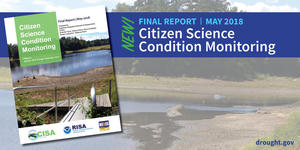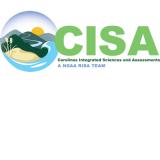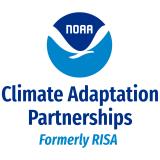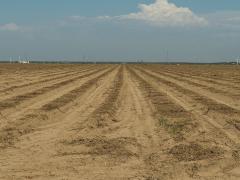For the latest forecasts and critical weather information, visit weather.gov.
CISA Publishes Newest Report on Citizen Science Condition Monitoring
A new report published by the Carolinas Integrated Sciences & Assessments (CISA), a NOAA RISA team, summarizes the evaluation results and recommendations for the future of the CoCoRaHS Citizen Science Condition Monitoring project.
 The Citizen Science Condition Monitoring project was created in an effort to increase understanding and awareness of the impacts of drought – both environmental and societal. The project was designed to pilot a new method of drought impacts reporting which incorporates elements of the Community Collaborative Rain, Hail, and Snow (CoCoRaHS) network. In contrast to situational drought reporting – usually submitted after drought conditions have become noticeably severe – this project focuses on regular condition monitoring reports submitted by volunteers on a weekly basis. This routine approach to monitoring is more effective at revealing subtle changes in patterns that indicate onset, intensification, or recovery of drought.
The Citizen Science Condition Monitoring project was created in an effort to increase understanding and awareness of the impacts of drought – both environmental and societal. The project was designed to pilot a new method of drought impacts reporting which incorporates elements of the Community Collaborative Rain, Hail, and Snow (CoCoRaHS) network. In contrast to situational drought reporting – usually submitted after drought conditions have become noticeably severe – this project focuses on regular condition monitoring reports submitted by volunteers on a weekly basis. This routine approach to monitoring is more effective at revealing subtle changes in patterns that indicate onset, intensification, or recovery of drought.
CISA’s evaluation focused on collecting and integrating feedback from observers and people using the reports to make decisions. Feedback from the initial phase of the project was incorporated into the second phase in order to streamline the reporting process to better enable volunteers to accurately and regularly report their observations. Tools and resources, including the condition monitoring web map, were also developed to make better use of the information volunteers provide. The improved condition monitoring report process and online tools facilitated the expansion of the project to a national scale.
Released this month, the report, Citizen Science Condition Monitoring Phase 2: January 2016 through December 2017, details the project improvements and evaluation the CISA team conducted throughout the second phase of this project and provides recommendations on next steps for the continued success of condition monitoring. Some of these recommendations include community outreach, technological investments, and standardizing condition monitoring guidance. Read the full report





